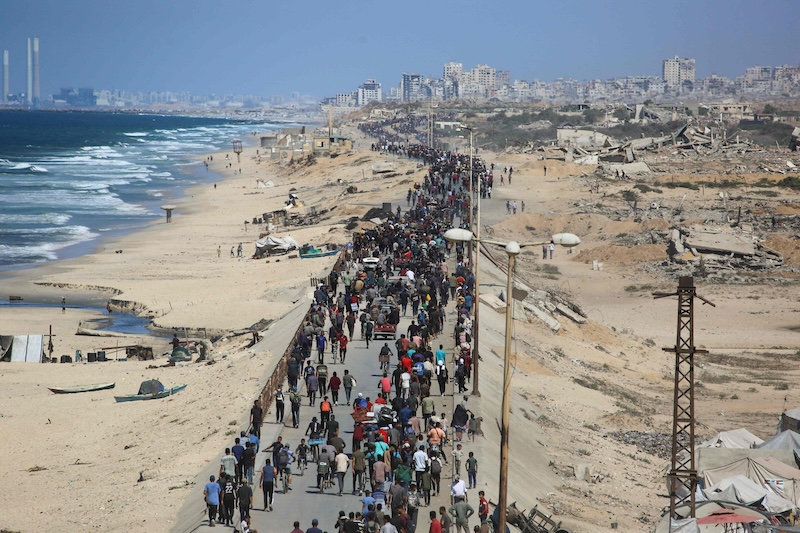Israeli troops have begun withdrawing from parts of Gaza following the activation of a ceasefire agreement brokered by US President Donald Trump, marking the first phase of a plan that includes hostage exchanges, humanitarian aid, and a phased military pullback.
At noon local time on Friday, the Israel Defense Forces confirmed that units had repositioned behind what officials described as the “yellow line”, a boundary detailed in Trump’s 20-point Gaza plan. The move triggered the return of thousands of displaced Palestinians to the north of the Strip.
The ceasefire, agreed without Palestinian participation, sets a 72-hour window for Hamas to release 20 living Israeli captives and the bodies of at least 26 others. In exchange, Israel is expected to release 250 Palestinian prisoners, many serving life sentences, and 1,700 detainees held from Gaza. The International Committee of the Red Cross will oversee the transfers.
Israeli Prime Minister Benjamin Netanyahu credited military pressure for the agreement but also thanked Trump for his role, saying on X that the US president “makes peace happen.” He later stated that Trump deserved the Nobel Peace Prize.
Netanyahu’s coalition had initially resisted the terms. Far-right Finance Minister Bezalel Smotrich, who voted against the deal, later claimed credit for preventing earlier prisoner swaps and insisted the final agreement validated his position.
Despite the ceasefire, Israeli military activity continued in parts of Gaza and the occupied West Bank. Airstrikes and drone activity were reported near Khan Younis and Gaza City, and military raids occurred in Nablus, Tubas, Ramallah, and East Jerusalem. In one case, Israeli forces demolished the home of a deceased Palestinian man.
Gaza’s civil defence authorities warned civilians not to return to areas still occupied or not yet cleared of explosives. The warning came as families began walking north from camps in al-Mawasi and Nuseirat, hoping to return to destroyed homes in Gaza City and Jabalia.
“We’ll go back, even if it’s rubble,” Wael al-Najjar, who had been displaced three times since the war began, told the BBC. “Even if the house is destroyed, we’ll put up a tent.”
The UN and humanitarian agencies reported that 198,883 buildings had been damaged in the Strip since October 2023. Gaza City, once the most populated area in the enclave, is among the most devastated. An estimated 74 percent of its structures have been hit.
Aid agencies say they are prepared to move in, with 600 aid trucks expected to cross into Gaza daily under the agreement. Supplies will include food, medicine, shelter materials, and fuel. The UN has pre-positioned over 170,000 metric tons of goods in neighbouring countries, waiting for clearance.
The UN’s humanitarian coordinator Tom Fletcher said that aid efforts will prioritise restoring water, healthcare, and education. UNICEF’s spokesperson Tess Ingram said more than 1,300 trucks are ready to deliver urgent supplies for children. She described conditions in al-Mawasi as “incredibly crowded”, with children sleeping under tarpaulin and walking barefoot through rubble.
Despite the start of aid deliveries, many challenges remain. Israel has retained control of more than half of Gaza’s territory. The first withdrawal phase does not include full evacuation from key urban areas like Beit Lahiya, Khan Younis, and large parts of Gaza City. All border crossings, including Rafah, remain under Israeli control.
The Trump plan outlines three withdrawal stages. The next involves an International Stabilisation Force overseeing a gradual Israeli pullback to a new line, followed by a final step establishing a smaller Israeli security buffer. The final governance of Gaza remains unresolved.
The Trump plan proposes a transitional Palestinian technocratic committee, supervised by an international “Board of Peace” led by Trump and including former UK Prime Minister Tony Blair. The Palestinian Authority is slated to resume control following internal reforms.
Hamas has not publicly agreed to disarm. Its fighters appeared on Gaza’s streets following the Israeli withdrawal, filling a security vacuum. Some wore insignia of the Hamas Internal Security agency. The Israeli government had aimed to eliminate Hamas from Gaza during the genocidal war, but its armed presence remains visible.
Qatar, Egypt, and Turkey have been named as key partners in the implementation phase. Qatar announced it will lead reconstruction efforts with financial and humanitarian support. It has stressed the importance of Palestinian self-determination in shaping the Strip’s future.
Russia has also backed Trump’s peace initiative. President Vladimir Putin said Moscow was open to supporting the transition, given its ties with the Arab world and the Palestinian leadership.
Germany pledged €29 million in humanitarian assistance and plans to co-host a reconstruction conference with Egypt.
At the political level, debate continues over the list of Palestinian prisoners to be released. Hamas has demanded the inclusion of senior figures like Marwan Barghouti, but Israel has refused. Some prisoners listed are being deported to third countries.
In the coming days, US forces will deploy 200 personnel to monitor the ceasefire from Israel, though they will not enter Gaza. Their role will be limited to oversight and verification of compliance.
Israeli authorities published security plans for Trump’s visit to Jerusalem on Monday. Operation “Blue Shield 6” will deploy thousands of officers to secure the US president’s movements. Trump is expected to address the Knesset before travelling to Sharm el-Sheikh for the formal signing of the ceasefire agreement.
Questions persist about the longevity of the ceasefire. Gaza’s media office demanded a full end to hostilities, unrestricted humanitarian access, and an international investigation into alleged war crimes. Palestinian groups called for the return and compensation of all displaced people.
UN officials, including Juliette Touma of UNRWA, say coordination with Israeli authorities has been minimal. The agency has not been officially asked to participate, despite having 12,000 staff in Gaza and managing most education and health facilities.
Trump’s administration claims the first phase of the plan has achieved more than previous efforts. But without clear agreement on governance, border control, and disarmament, observers say the risk of renewed conflict remains.
HT

